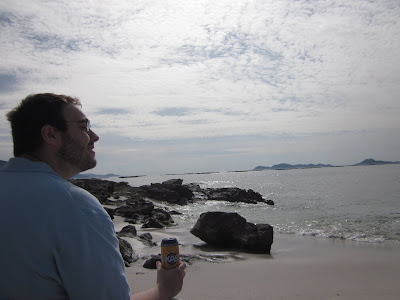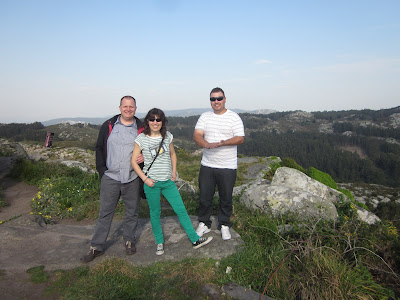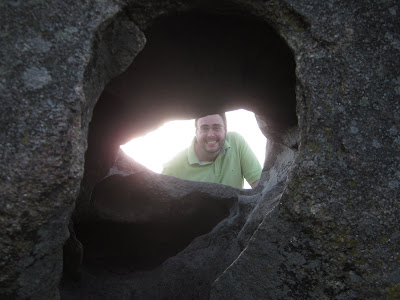Looming over the Tenerife at an altitude of 3,719 meters, El Teide needs no words to make an impression. This volcanic giant is one of Spain's most visited national parks--four of which are located on various Canary Islands. Rob and I decided to head straight to the top and made El Pico del Teide our first destination. As we wound our way up the precarious mountain roads I worried about the overcast skies and flecks of rain. (In my experience many of the world's famous mountains strangely resemble each other: Grey masses of clouds on the horizon...) At a café we were reassured, though, that the mountain had a climate of its own, that the weather down below had nothing to do with the weather up there. Sure enough, we broke through the clouds directly and found ourselves in another world altogether.
The entire park is a dramatic volcanic desert. Rob and I both remarked that it felt like we had left Spain and were back in the Americas--perhaps since most of our family vacations centered around wide open spaces, or because European tourism tends to favor historical wonders over natural ones. Whatever the reason, we were enchanted. There were even times when the molten landscape made it seem like we had left planet earth! The deep reds of the oxidized pumice made a beautiful contrast to the high-altitude blues of the sky, speckled with white clouds and evergreen trees. It might even be worth visiting the park more than once, as we read that the picture is constantly changing with the seasons. In the winter the mountain is covered in snow and ice (while tourists sunbathe on the beaches below), and as it gets warmer the runoff creates a "disappearing lake," which gives way to an explosion of yellow flowers in the spring, and then to the harsh red Martian landscape in the summer.
As a general rule, any national park is a worthy destination for me--There's usually a very good reason for the distinction! Also, a generally good travel tip is to look for an elevated spot where you can take in the view; it gives you a great perspective and makes for fabulous photos! (And if you can enjoy a coffee with a view, who can complain?) Rob and I took the laid-back approach and rode the cable car to the top of the monstrous Teide. Some adventurous people hiked their way up, and if you are really enthusiastic (and purchase a permit first) you can hike from the cable-car landing up the last stretch to the tippy top of the peak. Time allowing, I would probably do the hike, but what really impressed me were the people who biked their way up. No, not up the Pico del Teide: Into the park. All the way from the coast, through the midway mountain towns, and into the park. Rob and I made the trip more than once by car, and even with a motor the twists and turns on a steep incline make for an extreme journey! Every day we crossed paths with zealous cyclists powering their way up the hills, and on more than one occasion per day! I commend them.

Though we didn't have Lance Armstrong's stamina, Rob and I enjoyed the experience on foot. While the British basked on the beaches, and the Germans charged up the highest peaks, we were American and settled on the intermediate trails. (And only got lost in the lava fields a couple of times!) The crunch of lava rocks underfoot is a great way to experience the austere landscapes of El Teide. We spent two days exploring, but you could easily spend longer. If you come to Tenerife--no matter how you end up there--you have to visit El Teide!
Have you seen a volcano before? What do you think of extreme cyclists?

















































